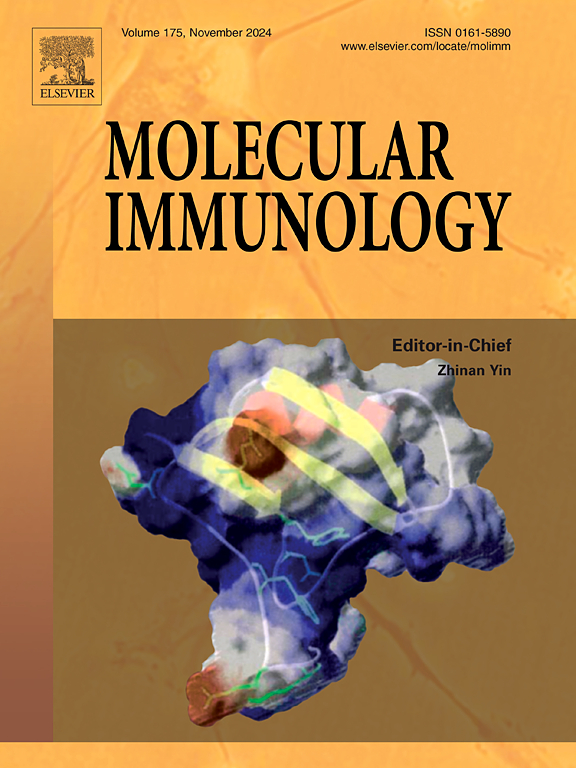Investigation of the anti-inflammatory, anti-oxidant and anti-apoptotic activity of 18β- glycyrrhetinic-acid on the model of LPS-induced lung injury in rats
IF 3.2
3区 医学
Q2 BIOCHEMISTRY & MOLECULAR BIOLOGY
引用次数: 0
Abstract
Introduction
Our aim was to investigate the protective effects of 18β-Glycyrrhetinic-acid (50 and 100 mg/kg i.g) on LPS-induced rat sepsis model by analyzing some immune mechanisms including inflammation, apoptosis, and oxidative stress parameters by different techniques such as Mallory’s Trichome staining, ELISA, tissue biochemistry and Western Blotting.
Methods
Forty-eight Sprague Dawley rats divided into 6 groups as follows: (i) Control, (ii) DMSO, (iii) LPS induced-Sepsis, (iv) LPS induced-Sepsis+ 18β-GA 50 mg/kg, (v) LPS induced-Sepsis + 18β-GA 100 mg/kg, (vi) 18β-GA 100 mg/kg. The pro-inflammatory cytokine (IFNγ, IL-1ß, TNF- α) levels were measured by ELISA technique. All rat’s lung tissues micrographed with Mallory’s Trichome stain. Oxidative stress parameters (MDA, GSH, SOD, NRF2, and HO-1), TLR4 signaling, and apoptotic proteins (Bcl-2 and Caspase-3) were detected by using tissue biochemistry and Western blotting.
Results
LPS administration caused a significant increase in all pro-inflammatory cytokine and oxidant levels. Shedding of bronchiolar epithelium, thickening of alveolar septa and vascular dilatation in LPS groups’ lung tissue were revealed according to the histopathological findings. The H-scores of 18β-GA50 +LPS and 18β-GA100 +LPS groups were significantly lower than LPS groups’ (p < 0.05). When lung tissue protein expression profiles were analyzed for HO-1, TLR4, IL-1β, TNF-α, Bcl-2, and Caspase-3 expression was higher in the LPS group than in the control. In addition, NRF2 and Bcl-2 protein expressions were higher in control, DMSO and 18β-GA100 groups, while it was the lowest level in LPS group.
Conclusion
18β-GA demonstrates significant protective effects against LPS-induced lung injury in rats by modulating various immune mechanisms. These findings indicate that 18β-GA, particularly at the higher dose, may be a potential therapeutic agent in managing sepsis by mitigating inflammation, oxidative stress, and apoptosis in lung tissue. The inflammation and oxidative stress parameters were decreased and the apoptotic markers were increased in treatment group. Further molecular studies should be performed to investigate the roles of some significant cellular signaling pathways.
18β-甘草次酸对lps致大鼠肺损伤模型的抗炎、抗氧化和抗凋亡活性研究。
目的:通过马洛里氏毛状染色、酶联免疫吸附、组织生化和Western Blotting等不同技术分析18β-甘草次酸(50和100 mg/kg .g)对lps诱导的大鼠脓毒症模型的炎症、凋亡和氧化应激等免疫机制,探讨其保护作用。方法:48只Sprague Dawley大鼠分为6组:(i)对照组,(ii) DMSO组,(iii) LPS诱导脓毒症组,(iv) LPS诱导脓毒症+ 18β-GA 50 mg/kg, (v) LPS诱导脓毒症+ 18β-GA 100 mg/kg, (vi) 18β-GA 100 mg/kg。ELISA法检测促炎细胞因子(IFNγ、IL-1ß、TNF- α)水平。所有大鼠肺组织用马洛里氏毛状染色显微照相。采用组织生化和Western blotting检测细胞氧化应激参数(MDA、GSH、SOD、NRF2、HO-1)、TLR4信号、凋亡蛋白(Bcl-2、Caspase-3)。结果:LPS可显著增加小鼠体内所有促炎细胞因子和氧化剂水平。病理观察显示LPS组肺组织细支气管上皮脱落,肺泡隔增厚,血管扩张。18β-GA50 +LPS组和18β-GA100 +LPS组的h评分显著低于LPS组(p )结论:18β-GA通过调节多种免疫机制对LPS诱导的大鼠肺损伤具有显著的保护作用。这些发现表明,18β-GA,特别是在高剂量下,可能是一种潜在的治疗药物,通过减轻肺组织中的炎症、氧化应激和细胞凋亡来治疗败血症。治疗组小鼠炎症、氧化应激指标降低,细胞凋亡指标升高。进一步的分子研究应该进行,以探讨一些重要的细胞信号通路的作用。
本文章由计算机程序翻译,如有差异,请以英文原文为准。
求助全文
约1分钟内获得全文
求助全文
来源期刊

Molecular immunology
医学-免疫学
CiteScore
6.90
自引率
2.80%
发文量
324
审稿时长
50 days
期刊介绍:
Molecular Immunology publishes original articles, reviews and commentaries on all areas of immunology, with a particular focus on description of cellular, biochemical or genetic mechanisms underlying immunological phenomena. Studies on all model organisms, from invertebrates to humans, are suitable. Examples include, but are not restricted to:
Infection, autoimmunity, transplantation, immunodeficiencies, inflammation and tumor immunology
Mechanisms of induction, regulation and termination of innate and adaptive immunity
Intercellular communication, cooperation and regulation
Intracellular mechanisms of immunity (endocytosis, protein trafficking, pathogen recognition, antigen presentation, etc)
Mechanisms of action of the cells and molecules of the immune system
Structural analysis
Development of the immune system
Comparative immunology and evolution of the immune system
"Omics" studies and bioinformatics
Vaccines, biotechnology and therapeutic manipulation of the immune system (therapeutic antibodies, cytokines, cellular therapies, etc)
Technical developments.
 求助内容:
求助内容: 应助结果提醒方式:
应助结果提醒方式:


